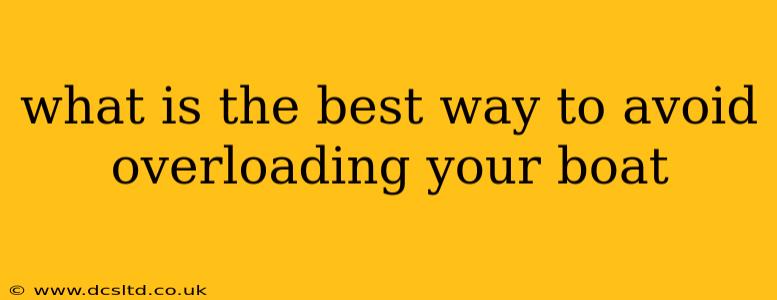Avoiding Boat Overload: A Comprehensive Guide to Safe Boating
Overloading a boat is a serious safety hazard, leading to capsizing, swamping, and even fatalities. Knowing your boat's weight capacity and adhering to safe loading practices are crucial for a safe and enjoyable boating experience. This guide outlines the best ways to avoid overloading your boat, covering essential aspects often overlooked.
What is the maximum weight capacity of my boat?
This is the most crucial piece of information. The maximum weight capacity, often referred to as the maximum load capacity or carrying capacity, is clearly stated on the boat's capacity plate. This plate, usually located near the stern (rear) of the boat, lists the maximum weight of people, gear, and equipment the boat can safely carry. Locate this plate immediately. If you can't find it, consult your boat's owner's manual or contact the manufacturer. Ignoring this capacity is reckless and dangerous.
What factors affect my boat's weight capacity?
Several factors beyond just the weight of passengers and gear influence your boat's safe load:
- Passengers' weight: Don't just count the number of people; accurately estimate their combined weight.
- Gear weight: Everything on board – anchors, ropes, fishing equipment, coolers, life jackets, etc. – adds weight. Be meticulous in weighing these items or making reasonable estimates.
- Fuel weight: A full fuel tank adds considerable weight.
- Engine weight: This is factored into the manufacturer's weight capacity calculation.
- Water displacement: The boat itself displaces water, and this affects its stability.
How do I calculate the total weight on my boat?
Carefully weigh or estimate the weight of every item you intend to bring aboard. Add up the weights of passengers, fuel, gear, and the boat itself. Never exceed the maximum weight listed on the capacity plate. If you're unsure about estimations, err on the side of caution and leave some items behind.
What happens if I overload my boat?
Overloading a boat significantly compromises its stability, increasing the risk of:
- Capsizing: The boat can easily flip over, especially in rough water or with sudden movements.
- Swamping: The boat can take on water, leading to sinking or loss of control.
- Reduced maneuverability: The boat becomes difficult to steer and control, increasing the risk of collisions.
- Lower freeboard: This is the distance between the waterline and the deck. Overloading lowers the freeboard, increasing the risk of waves washing over the deck.
How can I distribute weight evenly on my boat?
Even weight distribution is vital for stability. Distribute the heavier items low and centrally in the boat. Keep people and gear balanced across the boat’s beam (width). Avoid concentrating weight in one area.
What are some tips for safe boating practices besides avoiding overload?
- Always wear a life jacket.
- Check the weather forecast before heading out.
- Have a float plan and tell someone where you're going.
- Maintain your boat regularly.
- Know your boating limits and stay within your capabilities.
By understanding your boat's capacity and carefully managing its weight, you can significantly improve safety and enjoy a worry-free time on the water. Remember, a safe boating experience starts with respecting the limits of your vessel.
